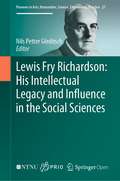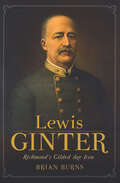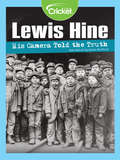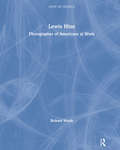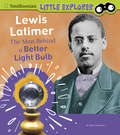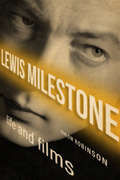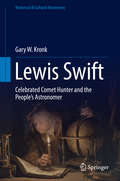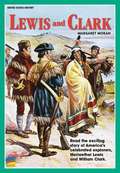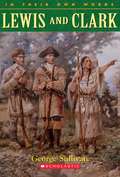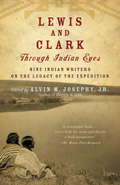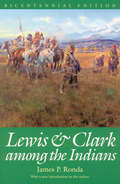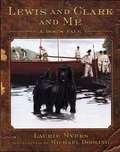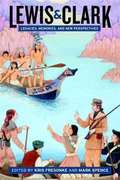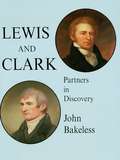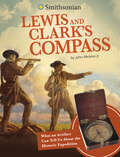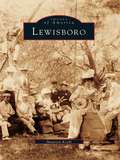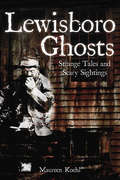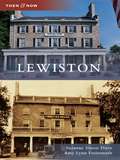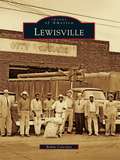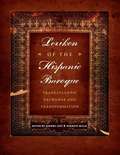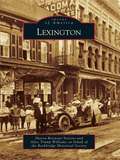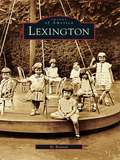- Table View
- List View
Lewis Fry Richardson: His Intellectual Legacy And Influence In The Social Sciences (Pioneers in Arts, Humanities, Science, Engineering, Practice #27)
by Nils Petter GleditschThis is an open access book. Lewis F Richardson (1981-1953), a physicist by training, was a pioneer in meteorology and peace research and remains a towering presence in both fields. This edited volume reviews his work and assesses its influence in the social sciences, notably his work on arms races and their consequences, mathematical models, the size distribution of wars, and geographical features of conflict. It contains brief bibliographies of his main publications and of articles and books written about Richardson and his work and discusses his continuing influence in peace research and international relations as well as his attitude to the ethical responsibilities of a scientist. It will be of interest to a wide range of scholars. This book includes 11 chapters written by Nils Petter Gleditsch, Dina A Zinnes, Ron Smith, Paul F Diehl, Kelly Kadera, Mark Crescenzi, Michael D Ward, Kristian Skrede Gleditsch, Nils B Weidmann, Jürgen Scheffran, Niall MacKay, Aaron Clauset, Michael Spagat and Stijn van Weezel.Lewis F Richardson occupied an important position in two academic fields as different as meteorology and peace research, with academic prizes awarded in both disciplines.In peace research, he pioneered the use of mathematical models and the meticulous compilation of databases for empirical research.As a quaker and pacifist, he refused to work in preparations for war, paid a heavy prize in terms of his career, and (at least in the social sciences) was fully recognized as a pioneering scholar only posthumously with the publication of two major books.Lewis Fry Richardson is one of the 20th century’s greatest but least appreciated thinkers—a creative physicist, psychologist, meteorologist, applied mathematician, historian, pacifist, statistician, and witty stylist. If you’ve heard of weather prediction, chaos, fractals, cliometrics, peace science, big data, thick tails, or black swans, then you have benefited from Richardson’s prescience in bringing unruly phenomena into the ambit of scientific understanding. Richardson’s ideas continue to be relevant today, and this collection is a superb retrospective on this brilliant and lovable man.Steven Pinker, Johnstone Professor, Harvard University, and the author of The Better Angels of Our Nature and Enlightenment Now
Lewis Ginter: Richmond's Gilded Age Icon
by Brian BurnsA biography of the nineteenth-century influential Richmond businessman.As a Confederate war hero, philanthropist and entrepreneur, Lewis Ginter was many things to Richmond. Performing integral missions for &“Stonewall&” Jackson and Robert E. Lee, Ginter was commended for gallantry on the battlefield and became affectionately known as the &“Fighting Commissary.&” After the war, Ginter was the first major marketer of the hand-rolled cigarette in America. He developed one of America&’s first streetcar suburbs and built the magnificent Jefferson Hotel, a symbol of Richmond&’s ambition and prosperity. But beyond the well-known history of this River City icon, there are many aspects of his personal and professional life that few know about. Join local writer Brian Burns as he delves into the hidden history of Ginter&’s extraordinary life to fill in the gaps between Ginter the man and Ginter the legend.&“By using many original sources, [Burns] writes of details of Ginter's life that even longtime Richmond-history buffs may not know.&” —Richmond Times-Dispatch
Lewis Hine: His Camera Told the Truth
by James RumfordIt was once common for children to work at jobs with little pay. Then a photographer named Lewis Hine urged this dangerous practice stop to with the power of his camera and the assistance of lawmakers. Learn more about the history of child labor in the United States and how it became outlawed.
Lewis Hine: Photographer of Americans at Work (Show Me America (group 1) Ser.)
by Richard WorthLewis Wickes Hines documentary photography helped promote the cause of the National Child Labor Committee, which published there declaration in 1913. This text is a collection of photographs showing children at work from 1910 to 1935 as Hines travelled across America.
Lewis Latimer: The Man Behind a Better Light Bulb (Little Inventor)
by Nancy DickmannWhy is Lewis Latimer important? His invention of the carbon filament made light bulbs more afforable and longer lasting. Readers follow his journey from working with Alexander Graham Bell to improving Thomas Edison's light bulb. It's an enlightening story filled with engaging text and colorful images, all reviewed by Smithsonian experts.
Lewis Milestone: Life and Films (Screen Classics)
by Harlow RobinsonA biography of the Oscar-winning director and a study of his acclaimed films, like All Quiet on the Western Front, The Front Page, and Of Mice and Men. This comprehensive biography is the first to present Lewis Milestone&’s remarkable life—a classic rags-to-riches American narrative—in full and explores his many acclaimed films from the silent to the sound era. Creator of All Quiet on the Western Front, Of Mice and Men, the original Ocean&’s Eleven and Mutiny on the Bounty, Lewis Milestone (1895-1980) was one of the most significant, prolific, and influential directors of our time. A serious artist who believed in film&’s power not only to entertain, but also to convey messages of social importance, Milestone was known as a man of principle in an industry not always known for an abundance of virtue. Born in Ukraine, Milestone came to America as a tough, resourceful Russian-speaking teenager and learned about film by editing footage from the front as a member of the Signal Corps of the US Army during World War I. During the course of his film career, which spanned more than 40 years, Milestone developed intense personal and professional relationships with such major Hollywood figures as Howard Hughes, Kirk Douglas, Marlene Dietrich, and Marlon Brando. Addressed are Milestone&’s successes?he garnered 28 Academy Award nominations?as well as his challenges. Using newly available archival material, this work also examines Milestone&’s experience during the Hollywood Blacklist period, when he was one of the first prominent Hollywood figures to fall under suspicion for his alleged Communist sympathies.Praise for Lewis Milestone&“This highly readable biography of Lewis Milestone delivers the definitive study of a leading Jewish émigré director in Hollywood from the 1920s to the 1960s who worked successfully across multiple genres. Robinson seamlessly layers the scholarly expertise of a noted film historian of Russia and the Soviet Union with a novelist&’s gift for narrative power and dramatic flair, bringing long overdue attention to Milestone&’s fascinating life and enduring artistic achievements.&” —Catherine Portuges, University of Massachusetts Amherst&“A welcome biography of a man whose films remain better known than his name . . . . Robinson concentrates on the key aspects of Milestone&’s life and career, never getting bogged down in plot synopses or other minor issues. Rather than shoveling up endless rubble, he offers us the milestones of Milestone. Robinson&’s story is as tight as most classic Hollywood films, and that deserves to be heralded. This is a book equally as valuable to film buffs as to academic scholars, speaking to readers inside and outside the academy.&” —LA Review of Books
Lewis Swift: Celebrated Comet Hunter and the People's Astronomer (Historical & Cultural Astronomy)
by Gary W. KronkThis biography covers the life of Lewis Swift (1820-1913), who discovered 13 comets and nearly 1,200 other deep sky objects. All 13 comets found by Swift now bear his name, including three periodic comets with periods of 6 years (11P/Tempel-Swift-LINEAR), 9 years (64P/Swift-Gehrels), and 133 years (109P/Swift-Tuttle).Swift's enthusiasm and success as an amateur astronomer helped make him famous in the United States. With the help of others, Swift was able to buy a 16-inch refractor, the third largest telescope in the United States at the time. Hulbert Harrington Warner built "Warner Observatory" to house this telescope. As a prolific writer and lecturer, Swift's stories appeared in newspapers and magazines, while his lectures showed that he was able to explain anything in a way that everyone could understand. When Warner went broke during the "Panic of 1893," Swift was forced to leave his home. Almost two dozen invitations arrived from around the United States asking him to bring his telescope to their city, and he eventually accepted the invitation of Californian Thaddeus Sobieski Constantin Lowe. This book highlights Swift's valuable contributions to astronomy before failing eyesight forced him to give up this profession. In addition to detailing Swift's life, biographical material is also provided for a number of individuals who were influenced by Swift. This includes his son, Edward, who was discovering deep sky objects as a teenager.
Lewis and Clark
by Pam Hirschfeld Margaret MoranFind out about Meriwether Lewis and William Clark by joining them on their journey as they meet many people who help guide them on their search for the Northwest Passage. (Set of 6 with Teacher's Guide and Comprehension Question Card)
Lewis and Clark (In Their Own Words)
by George SullivanDrawing on the explorers' journals and other primary sources, this book recounts the story of the Lewis and Clark expedition, exploring the uncharted western wilderness, placing it in its historical context. Includes historic prints, maps, photos, chronology, bibliography, and further reading lists.
Lewis and Clark Among the Indians
by James P. RondaThe Lewis and Clark expedition has long symbolized the westering impulse in American life. No other exploring party has so fully captured the imagination of ordinary citizens or the attention of scholars. In ways that defy rational explanation, the picture of Lewis and Clark struggling up the Missouri and across the mountains to the great western sea continues to stir our national consciousness. Books, highway markers, museum displays, and a foundation dedicated to preserving the Lewis and Clark trail all bear witness to a fascination that time has only deepened. Over the generations since the expedition returned from the Pacific, its achievement and significance for America heading west have undergone constant reappraisal. From an early emphasis on the journey as an epic of physical endurance and courage, Lewis and Clark have emerged in this century as pioneer western naturalists, cartographers, and diplomats. Thomas Jefferson, the man William Clark once called "that great Character the Main Spring" of the expedition, would have heartily endorsed an evaluation of the Corps of Discovery that included sharp minds as well as strong bodies. And Jefferson would have reminded us that his explorers were part of that long encounter between Euro-Americans and native Americans. In its daily affairs and official actions, the expedition passed through, changed, and was in turn changed by countless native lives. In the simplest terms, this book is about what happens when people from different cultural persuasions meet and deal with each other. The Lewis and Clark expedition was an integral and symbolic part of what James Axtell has aptly called "the American encounter." Nearly two and a half years of almost constant contact between explorers and Indians illuminate the larger and longer series of cultural relationships that began centuries before on the margins of the continent. This book is not a retelling of the familiar Lewis and Clark adventure. That story has been told with grace and skill by Bernard DeVoto and in the magnificent photographs of Ingvard Eide and David Muench. But readers will find moments of high drama not previously well known or clearly understood.
Lewis and Clark Through Indian Eyes
by Alvin M. Josephy Jr.At the 200th anniversary of the Lewis and Clark expedition recently, the Indian voice went virtually unheard, notes the late Josephy (former vice president and editor of American Heritage magazine). He commissioned these nine essays, penned by Indian writers, historians, and tribal executives (including the late Vine Deloria, Jr. ), as a corrective. The essays, varied in tone and method, were written in response to the question: "What impact, good or bad, immediate or long-range, did the Indians experience from the Lewis and Clark expedition?" Annotation ©2006 Book News, Inc. , Portland, OR (booknews. com)
Lewis and Clark among the Indians
by James P. Ronda"Particularly valuable for Ronda's inclusion of pertinent background information about the various tribes and for his ethnological analysis. An appendix also places the Sacagawea myth in its proper perspective. Gracefully written, the book bridges the gap between academic and general audiences."—Choice
Lewis and Clark and Me: A Dog's Tale
by Laurie MyersSeaman, Meriwether Lewis's Newfoundland dog, describes Lewis and Clark's expedition which he accompanied from St. Louis to the Pacific Ocean.
Lewis and Clark for Kids: Their Journey of Discovery with 21 Activities (For Kids series)
by Janis HerbertJoin Meriwether Lewis and William Clark's Corps of Discovery as they navigate the muddy Missouri River and begin a great adventure set against the background of the vast North American continent. Lewis and Clark for Kids takes children from President Jefferson's vision of an exploratory mission across a continent full of unique plants and animals through their dangerous and challenging journey into the unknown to the expedition's triumphant return to the frontier town of St. Louis. Twenty-one activities bring to life the Native American tribes they encountered, the plants and animals they discovered, and the camping and navigating techniques they used. A glossary of terms and listings of Lewis and Clark sites, museums, and related Web sites round out this comprehensive activity book.
Lewis and Clark: Legacies, Memories, and New Perspectives
by Mark David Spence Kris FresonkeAn interdisciplinary collection of essays that explores the legacy of the Lewis and Clark Expedition, and offers new perspectives on these American icons.
Lewis and Clark: Partners in Discovery (Dover Books On Travel, Adventure)
by John BakelessFirst authoritative biography of two great explorers. Based on original research and diaries of expedition members, book records day-by-day occurrences, dangers, hardships, Indian customs and lore, much more. Contains much material unknown before original publication. 29 illustrations and 7 maps.
Lewis and Clark’s Compass: What an Artifact Can Tell Us About the Historic Expedition (Artifacts from the American Past)
by John Micklos Jr.The Louisiana Purchase in 1803 nearly doubled the size of the United States. The U.S. suddenly went from consisting of 17 states along the Atlantic coast to claiming land as far west as present-day Montana. The U.S. government knew little about the terrain there. Was there a water route to the Pacific? President Thomas Jefferson sent William Clark and Meriwether Lewis to find out. With nothing to guide them but a compass, what would Lewis and Clark discover? Readers will find the answer to this question and how an artifact can tell us about U.S. history.
Lewisboro
by Maureen KoehlThe history of a town is found in the faces of its people and the places familiar to them. It is the story of the families that lived, worked, and played together over the years. With Lewisboro, the reader is invited to take a fascinating step back in time to view the history of this Westchester County town as it unfolds. The town is divided into six hamlets that are each proud of their unique heritage: Vista, Lewisboro, South Salem, Waccabuc, Cross River, and Goldens Bridge. Primarily a rural farm community in the nineteenth and early twentieth centuries, the introduction of the New York City Reservoir System and improved highways changed Lewisboro in many ways. Its lakes became lake communities offering affordable vacation homes; its farms became neighborhoods; and the railroad made commuting a way of life. Slowly the town grew.
Lewisboro Ghosts: Strange Tales and Scary Sightings (Haunted America)
by Maureen KoehlOn the easternmost edge of Westchester County, among the quiet communities nestled against the Connecticut state line, memories of eerie incidents and haunted happenings flow through the generations like the currents of the nearby Hudson River. The old-timers of South Salem and Waccabuc still recall the legendary"Leather Man," an itinerant vagabond who rambled mysteriously through the region in the late 1800s. Over in Goldens Bridge they whisper of "the Christmas Soldier," an apparition of a Revolutionary-era Patriot who stalks the Highway 22 corridor. And beneath Long Pond Mountain the locals listen attentively for the "Wail of the Wind," the sorrowful moan attributed to two ghostly parents lamenting their son's drowning. Read Maureen Koehl's Lewisboro Ghosts to discover the spooky stories and supernatural sightings that linger in this tucked-away corner of the lower Hudson Valley.
Lewiston
by Amy Lynn Freiermuth Suzanne Simon DietzLewiston, New York, a village and town on the mighty Niagara River, was destroyed during the War of 1812. Rebuilding began in the embers from that war, and the ongoing transformation has created a popular tourist destination for music, theater, festivals, and more. Historian Suzanne Simon Dietz and photographer Amy Lynn Freiermuth combined their talents to create Lewiston by selecting images from local museums, libraries, newspaper archives, and private collections.
Lewisville (Images of America)
by Robin Cole-JettOriginally known as Holford's Prairie, Lewisville's name is not the only thing that has changed about this town in its long history. Settlers sponsored by the Peters Colony Company founded the small community in the 1840s. In the ensuing years, the settlement, renamed to Lewisville by Basdeal W. Lewis in 1856, consistently grew and prospered until its incorporation in 1925. Cotton farming and ginning, the arrival of the Dallas and Wichita Railroad in 1881, the expansion of Lake Dallas into Lake Lewisville in 1954, and the opening of the Dallas/Fort Worth International Airport in 1974 ensured that Lewisville became an important commercial center in booming North Texas. Throughout its phenomenal growth, however, Lewisville still retained the charm and bonds of its farm-centered past. Today Lewisville boasts the largest population and school district in Denton County and serves as a suburb for the bustling Dallas/Fort Worth Metroplex.
Lexikon of the Hispanic Baroque: Transatlantic Exchange and Transformation
by Kenneth Mills Evonne LevyOver the course of some two centuries following the conquests and consolidations of Spanish rule in the Americas during the late fifteenth and early sixteenth centuries-the period designated as the Baroque-new cultural forms sprang from the cross-fertilization of Spanish, Amerindian, and African traditions. This dynamism of motion, relocation, and mutation changed things not only in Spanish America, but also in Spain, creating a transatlantic Hispanic world with new understandings of personhood, place, foodstuffs, music, animals, ownership, money and objects of value, beauty, human nature, divinity and the sacred, cultural proclivities-a whole lexikon of things in motion, variation, and relation to one another. Featuring the most creative thinking by the foremost scholars across a number of disciplines, the Lexikon of the Hispanic Baroque is a uniquely wide-ranging and sustained exploration of the profound cultural transfers and transformations that define the transatlantic Spanish world in the Baroque era. Pairs of authors-one treating the peninsular Spanish kingdoms, the other those of the Americas-provocatively investigate over forty key concepts, ranging from material objects to metaphysical notions. Illuminating difference as much as complementarity, departure as much as continuity, the book captures a dynamic universe of meanings in the various midst of its own re-creations. The Lexikon of the Hispanic Baroque joins leading work in a number of intersecting fields and will fire new research-it is the indispensible starting point for all serious scholars of the early modern Spanish world.
Lexington
by Rockbridge Historical Society Sharon Ritenour Stevens Alice Trump WilliamsLexington, the seat for Rockbridge County, is situated in the beautiful Shenandoah Valley within minutes of the Blue Ridge Mountains. Main Street is part of Route 11--the Valley Pike/Great Road--and the architecture downtown looks much as it did in the 19th century. Lexington is home to Washington and Lee University and Virginia Military Institute. It is also the final resting place for Thomas "Stonewall" Jackson and Robert E. Lee, as well as their horses. Within a few blocks, one visits the Stonewall Jackson House, Lee Chapel Museum, the VMI Museum, and the George C. Marshall Library Museum.
Lexington
by Bo BennettLexington, North Carolina, heralded as the "Barbecue Capital of the World," is located in the heart of the Triad, just 30 miles from High Point, Winston-Salem, and Greensboro. Along with barbecue, the town enjoys a rich history in the furniture business and textile industry. Legend claims that the European families who made Lexington their home in the early 1700s named it after a battle of the American Revolution. On April 19, 1775, the brave soldiers of Lexington, Massachusetts, armed themselves and courageously fought the British, losing seven American lives. News of their courage reached North Carolina, and it was decided to name the town in honor of the place whereone of the first known British resistances occurred.
